Get new posts by email or rss feed
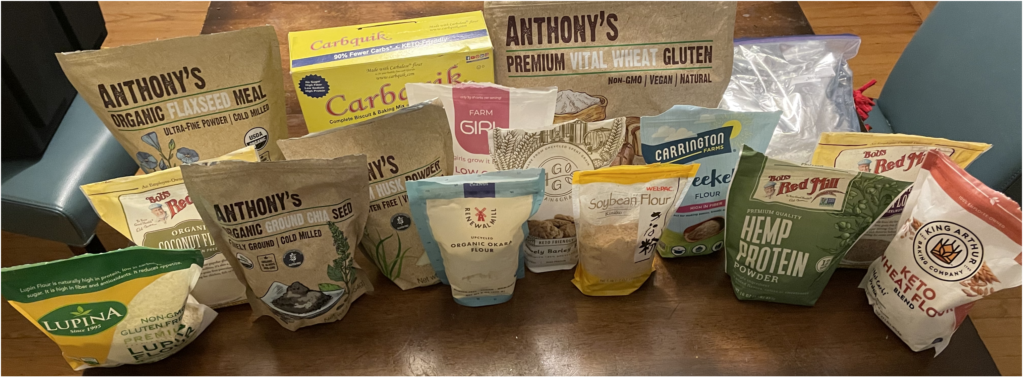
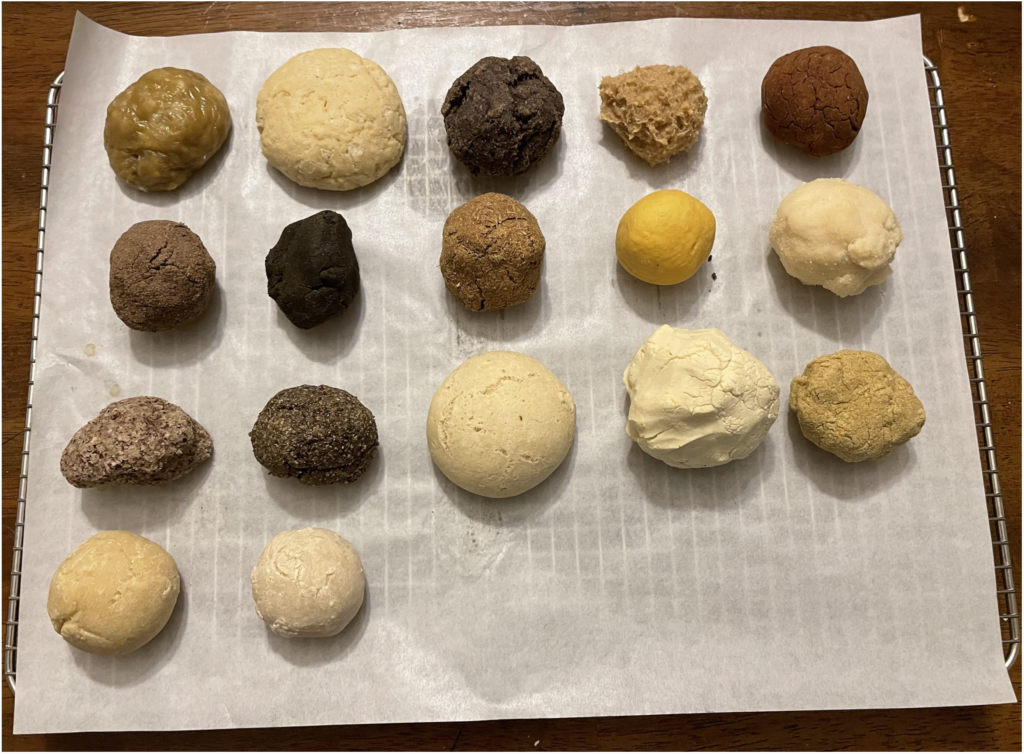
This post is an update on my experiments measuring the effect of low-carb foods and dietary supplements on blood sugar.
This week, I have the results from low-carb flour replacements. Next up will be whole foods (meats, vegetables, seeds & nuts, etc.).
Testing Queue:
- Prepared foods:
- Tortillas: Reported
- Cereal: Reported
- Ice Cream: Reported
- Bread: Reported
- Meal replacements: in queue, (Ketochow reported)
- Chocolate: Reported
- Ingredients:
- Macronutrients & sugar substitutes: Reported
- Flour replacements: this post
- Whole foods: testing
- Supplements:
- Vinegar: Initial replication, more experiments in queue
- MSG: Reported
Flour Replacements
Summary
When making low-carb baked goods, I find that the most difficult ingredient to replace is flour. Flour provides bulk, absorbs water, and binds ingredients together, creating the structure of most baked goods. Unfortunately, flour is ~75% starch by weight with a glycemic index of 70, resulting in an extremely high impact on blood sugar.
Historically, there hasn’t been a lot of low-carb replacements for flour available, mostly almond flour, coconut flour, and resistant starches. Similar to other low-carb products, a ton of new flour replacements have hit the market in the last few years. As always, the net carb counts look good, but I wanted to test them to see if they really hold up (see evidence of blood glucose impact of dietary fibers here & here).
Between my own searching and reader recommendations (1, 2, 3), Foods. I tested 18 flours from 6 different categories (grouped by main ingredient). Here’s my overall conclusions:
- Most Similar to Wheat Flour: Carbalose
- <30% BG impact of wheat flour, <20% of white bread
- texture & water uptake very similar to wheat flour
- Lowest BG impact: Ground chia seeds
- 12% of wheat flour, 8% of white bread
- Best Binders: Gluten, chia seeds, flaxseed, and psyllium husk
- These work great to tune the texture of other flour replacements
- Which one is best to use probably depends on the specific recipe/desired texture
- Best Pre-made Blends: King Arthur Keto Flour & Carbquik
- King Arthur is a flour substitute, though more elastic/chewy
- Carbquik is like Bisquik and great for biscuits, pancakes, muffins, and other airy baked goods.
Details
Purpose
- To identify low-carb foods that taste good and have minimal effect on my blood glucose.
- To determine the effect of popular, literature supported dietary supplements on my blood glucose.
Background
When making low-carb baked goods, I find that the most difficult ingredient to replace is flour. Flour provides bulk, absorbs water, and binds ingredients together, creating the structure of most baked goods. Unfortunately, flour is ~75% starch by weight with a glycemic index of 70, resulting in an extremely high impact on blood sugar.
Historically, there hasn’t been a lot of low-carb replacements for flour available, mostly almond flour, coconut flour, and resistant starches. Similar to other low-carb products, a ton of new flour replacements have hit the market in the last few years. As always, the net carb counts look good, but I wanted to test them to see if they really hold up (see evidence of blood glucose impact of dietary fibers here & here).
Between my own searching and reader recommendations (1, 2, 3), I found 18 flour replacements to test.
Design/Methods
Foods. I tested 18 flours from 6 different categories (grouped by main ingredient):
- Regular (wheat flour)
- Modified Starch
- Nuts
- Beans
- Other seeds
- Mixtures
Each flour was mixed with 2.5 wt% salt (for tasted) and enough water to make a cohesive dough. The dough was kneaded, baked at 350 °F until fully cooked through, and then cooled completely before eating. On weekdays, the cooked dough was stored in a sealed container overnight before eating the next day.
Full nutrient and ingredient info here. Key nutrition facts in the table below.
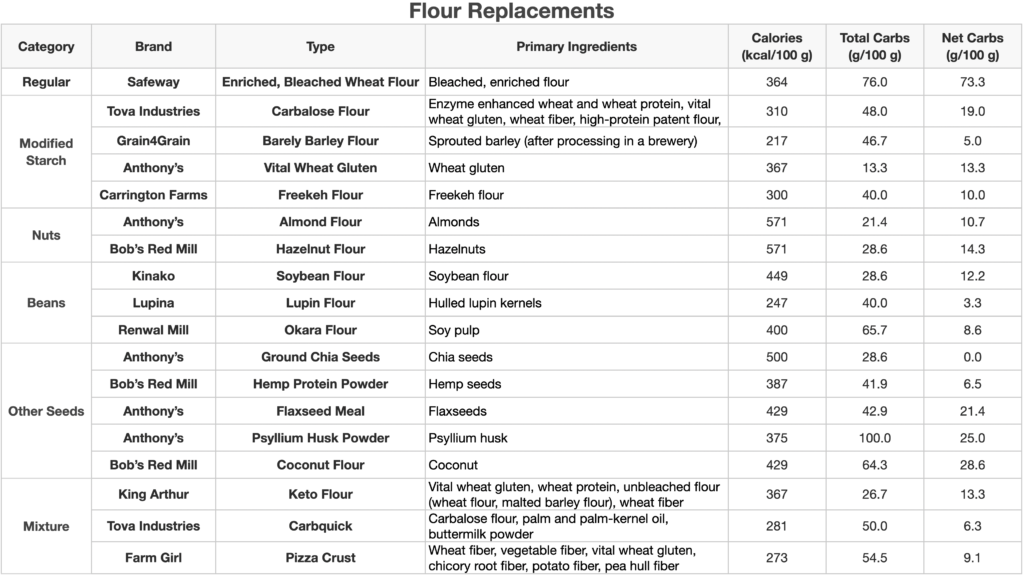
Procedure. At 5:00a, I took 4.5u of Novolog (fast acting insulin, duration of 2-4h), then drank a Ketochow shake (website, BG testing) at 5:30a. After that, no food or calorie-containing drinks were consumed and no exercise was performed. Non-calorie-containing drinks were consumed as desired (water or caffeine-free tea). At 10:30am-12 pm, the substance to be tested was eaten as rapidly as comfortable and notes on taste and texture were recorded (before observing any change in blood sugar).
Blood sugar was monitored for 5h using a Dexcom G6. Calibration was performed 15-30 min. before the start of each experiment.
Data Processing & Visualization. iAUC was calculated using the trapezoid method (see data spreadsheet for details). Data was visualized using Tableau.
Medication. During these experiments, I took long-acting basal insulin each evening at 9pm (Lantus, 1 u) and 2000 mg of metformin and multivitamin each morning at 5am. I did not dose for the experimental food ingested.
Data
- Formatted raw data, peak blood glucose, iAuC, and time to peak data
- Summary data, ingredient details, and taste assessments
Results & Discussion
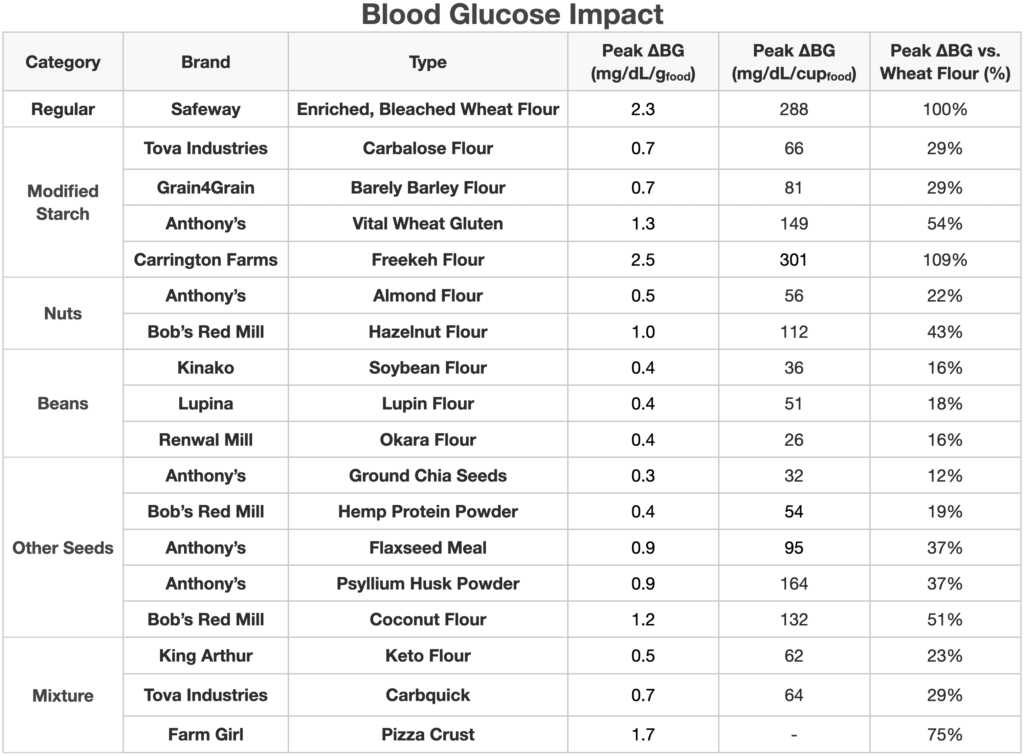
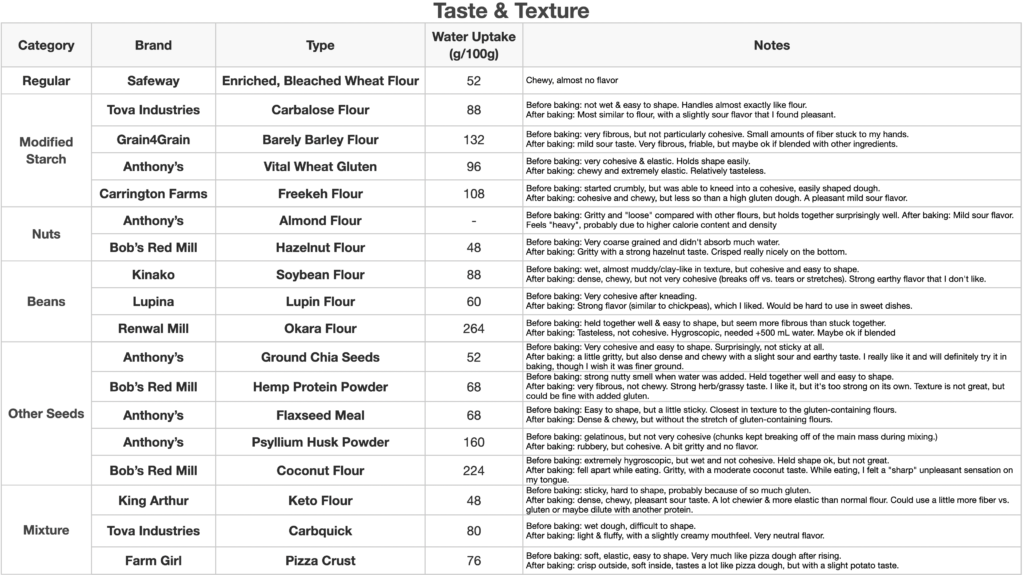
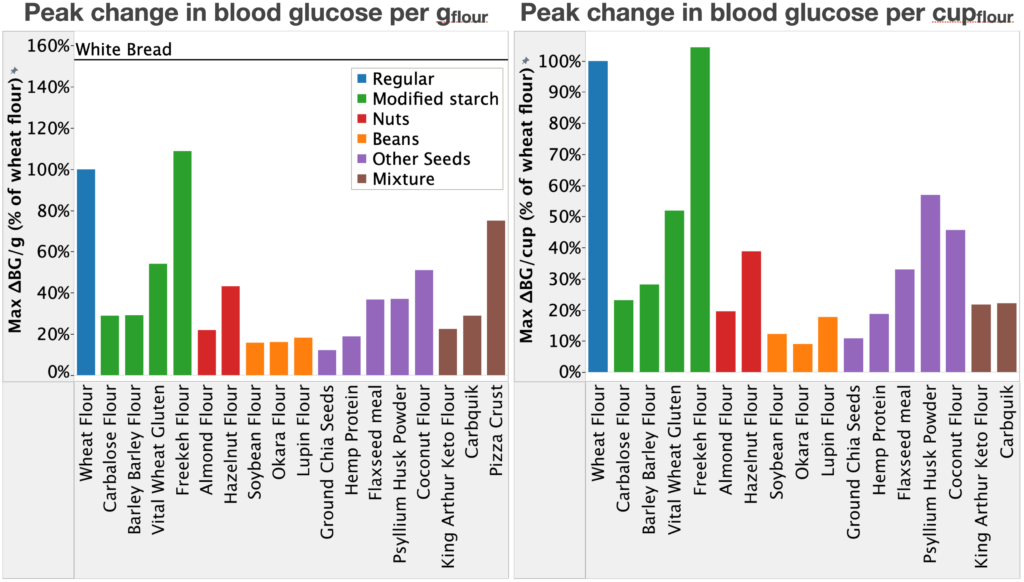
There’s a lot of data here and large variations between & within categories. To keep things organized, I will split the discussion up by category.
Regular Wheat Flour
As mentioned above, flour is ~75% starch by weight with a glycemic index of 70. It’s blood glucose impact is consistent with this, coming in at 2.3 mg/dL/g, or 3.2 mg/dL/netCarb. This is lower than the 4.8 mg/dL/netCarb I get for both dextrose & white bread, and could be due to measurement error (I could only eat ~6g of flour while keeping my BG in the target range).
Modified Starch
Several of the flour replacements use a modified form of wheat that is claimed to have a lower carbohydrate content:
- Carbalose flour uses an enzyme to either remove starch or make it resistant to digestion
- Barely Barley uses spent barley from beer production, where the yeast has consumed the majority of the starch
- Vital wheat gluten is the gluten separated from wheat flour (with some residual starch)
- Freekeh flour is made from durum wheat and claims a low net-carb count on its nutrition label
With the exception of Freekeh flour, these performed much better than I expected based on my previous bad experiences with resistant starches (tortillas, breads), with both carbalose & spent barley coming in at <30% BG impact of flour (<20% vs. white bread).
Carbalose, in particular, had a texture & water uptake extremely similar to regular flour, and could probably be used as a near 1:1 substitute. Spent barley was a lot more fibrous and not particularly cohesive. It would need to be blended with something more cohesive, like gluten, to be useable as more than a filler.
Gluten had a much higher BG impact, more than expected for the net carbs and likely coming from gluconeogenesis from its high protein content. Texture-wise, it was extremely elastic. Anecdotally, I’ve found that blending it with less-cohesive flour replacements at ~10 wt% (% of protein in wheat flour) makes for a good substitution in most baking recipes.
Lastly, Freekeh flour had a huge impact on my blood glucose, almost identical with wheat flour and far more than the claimed 10 g net carbs/100g would predict. I can only conclude that the nutrition label is wildly incorrect. From a quick google search, the USDA claims Freekeh has 67 g net carbs/100g compared with the 10g/100g claimed by Carrington Farms. That’s not definitive, as starch and fiber content can vary based on variety and time of harvest, but coupled with my BG measurements, it’s very suggestive.
Nuts
Both almond and hazelnut flours came in about where you’d expect based on their net carb and protein counts. Almond flour was ~20% BG impact of wheat flour (13% of white bread) and hazelnut flour was ~40% (27% vs. white bread).
Texture-wise, nut flours are substantially less cohesive than wheat flour, but can be blended with gluten, flaxseed, psyllium husk, or other more cohesive flour replacements to get the desired texture.
There are tons of other nut flours available, each with slightly different flavors and carb counts, but almond is by far the most common and cheapest.
Beans
While most beans have relatively high carb content, a few do not. I found flours made from soybeans, okara (dried soybean dregs from tofu manufacturing), and lupin beans. All three had very low blood glucose impact, 16-18% of wheat flour (11-12% of white bread) and were very cohesive and easy to shape.
The two soybean-based flours were extremely hydroscopic and would need to be blended in order to be useable in baking.
Lupin flour, on the other hand, can be kneaded into a cohesive, elastic dough, very similar to regular flour. After baking, it had a texture very similar to wheat flour. It does have a strong taste, similar to chickpeas, but more intense. I like it, but it would be difficult to use in sweet dishes. I’ve used it to make really good fritters and will probably experiment more with it in the future.
Other Seeds
There are a number of other seed flours that don’t fall neatly into the above categories. These all came in about where you’d expect based on their net carb and protein counts.
More interested was texture. Chia, flaxseed, and psyllium husk all contain mucin, a high molecular weight, protein that forms very cohesive gels. This is similar to gluten and can be used to provide a similar texture to baked goods when blended as a minor ingredient with other flour replacements.
Most notable was the ground chia seeds, which had the lowest BG impact (12% of wheat flour, 8% of white bread), most cohesive texture, and a slightly sour and earthy taste that I really liked. This one was new to me and I haven’t seen it used much in keto baking recipes. I will definitely be experimenting more with it in the future.
Mixtures
In addition to the single-ingredient flour replacements, I also tried 3 different pre-made blends:
- King Arthur Keto Flour is a mix of wheat gluten, wheat protein, flour, and wheat fiber. BG impact is low, 23% of regular wheat flour (15% of white bread) and taste, texture, and water uptake are similar to regular flour, exactly what I’d expect from a company who’s main product is regular flour :). It was a lot chewier and more elastic than regular flour, so I think it could use a little more fiber vs. gluten, but overall a very good substitute.
- Carbquik is a Bisquik substitue made using carbalose flour. Similar BG impact to carbalose and goes great in airy baked goods like biscuits pancakes, and muffins. I use it all the time.
- Farm Girl Pizza crust is a mix of wheat fiber, vegetable fiber, gluten, chicory root, potato fiber, and pea hull fiber. Texture & taste were very similar to pizza dough, but the BG impact was ~75% of flour (50% of white bread), much higher than predicted from the net carb count. Not sure which of the fibers caused the problem, but some of them are definitely digestible.
Thoughts & Next Experiments
With a few notable exceptions (Freekeh flour & Farm Girl pizza crust), the flour replacements performed as you’d predict from the net carb count, with many having very low blood glucose impact. None provided the full suite of taste and texture properties of regular flour, but some came surprisingly close.
Here’s my overall conclusions:
- Most similar to wheat flour: Carbalose
- <30% BG impact of wheat flour, <20% of white bread
- texture & water uptake very similar to wheat flour
- Lowest BG impact: Ground chia seeds
- 12% of wheat flour, 8% of white bread
- Best Binders: Gluten, chia seeds, flaxseed, and psyllium husk
- These work great to tune the texture of other flour replacements
- Which one is best to use probably depends on the specific recipe/desired texture
- Best Pre-made Blends: King Arthur Keto Flour & Carbquik
- King Arthur is a flour substitute, though more elastic/chewy
- Carbquik is like Bisquik and great for biscuits, pancakes, muffins, and other airy baked goods.
As always, please let me know in the comments if you have any thoughts, suggestions, or anything else you’d like to see me test.
– QD
Excellent write-up, as usual QD. If you were going to make a pizza using one of these flours, which one would you choose?
Good question. If I had to pick one, I’d try the carbalose. If I was going to experiment with blends, I’d try the King Arthur with some added fiber, maybe oat fiber. Lupin would be interesting to try too, but not sure how much the taste would interfere.
Re your interesting BG results & comments on ground chia seeds, carbalose, and Lupin flour. As some say Lupina & Miracle brands are closest to neutral taste, maybe you’d experiment with these brands vs carbalose & King Arthur… I’ve been using another brand in biscuits & quick breads & we notice no problem with taste. Thanks much!
Murray
The one I tested was the Lupina brand. I’ll try out the Miracle one.
All that said, I really like the lupina brand, just in savory dishes.
Please can you confirm which type of carbalose you used here. Seems there’s the “ Carbalose All-Purpose Low-Carb Flour (brown package)” and “Carbalose Lo-carb White Flour (foil package).
Carbalose Lo-carb White Flour (foil package). I haven’t seen the other kind. I’d be interested to try it, though, do you have a link?
Thank you soo much for this breakdown
Fantastic work, as always! Thanks for doing this! I had read this before but came back to review the details I had forgotten.
I hope you are well.
Wow… thank you for such a great analysis!! I use carbquik…love it… but with the skepticism that it’s too good to be true. Thanks for allaying my fears!! Have you heard of Wio Smart flour? Love to read your thoughts on it.
Thanks again!
Lori
I hadn’t heard of Wio before. Interesting concept, but I found reports of people testing it and seeing a pretty substantial spike in blood sugar (https://www.reddit.com/r/keto/comments/11h0qec/wio_foods_yay_or_nay/) (https://low-carb-scams.com/the-low-carb-wio-diet-scam/). I ordered some to give a shot myself, but I’m pretty sure the carbs are actually digestible.